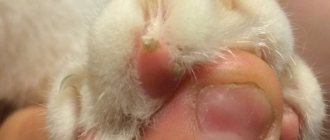What will you learn from the article?
- What is pulmonary edema What happens with pulmonary edema
- Stages of pulmonary edema
- Cardiogenic
- First aid
A diagnosis of pulmonary edema in cats always sounds like a death sentence. The sudden nature of the disease, the many reasons that cause it, the rapidly deteriorating clinical picture - this frightens the owners. To save your beloved pet, you need to overcome your own confusion and fear. Pulmonary edema is a terrible diagnosis, but not always fatal! The life of the cat depends on the quick and competent actions of the owner and the veterinarian.
In this article we will talk about what kind of pathology this is, what causes it and how it manifests itself, and whether it can be cured.
Causes of the disease
Pulmonary edema is not an independent disease, but a process that develops against the background of infectious or non-infectious diseases. Veterinarians divide all the causes that cause fluid accumulation in the alveoli of the lungs into two large groups - cardiogenic and non-cardiogenic.
Cardiogenic causes refer to heart diseases, which can be congenital or acquired. Some destructive processes in the heart and blood vessels impair the flow of blood and lymph, which leads to stagnation of fluid and filling of the lungs with it. Hypertension, pulmonary embolism, cardiosclerosis, aortic heart disease and other pathologies can lead to pulmonary edema.
Non-cardiogenic causes of pulmonary edema include various disorders in the body, inflammation, infectious and non-infectious diseases, injuries, allergies, tumors, poisoning with toxic fumes, burns of the respiratory tract and even electric shock.
By the way, many cat owners even assume that simple obesity can lead to edema.
Causes of pathology
There are many reasons why swelling occurs. They are divided into cardiogenic (heart-related) and non-cardiogenic.
Cardiogenic
Due to diseases of the cardiovascular system in the lungs, blood flow in the capillaries is disrupted. As blood flow slows, fluid from the blood vessels enters the cat's lungs.
Cardiogenic pulmonary edema in a cat occurs when:
- Hypertrophic cardiomyopathy.
- Chronic heart valve diseases.
- Heart defect.
- Heart failure.
- Arterial hypertension.
- Cardiosclerosis.
- Pulmonary embolism.
Important!
Most often, these causes of pulmonary edema occur in cats of artificially bred breeds.
Non-cardiogenic
This type includes all other conditions that are not related to the work of the heart.
- Allergic reactions (including to anesthesia).
- Aspiration pneumonia.
- Injuries to internal organs as a result of falls from height.
- Electric shock.
- Reaction to medications.
- Choking (carbon smoke poisoning).
- Anemia.
- Heatstroke.
- Lung cancer.
- Laryngeal paralysis.
- Head injuries: bruise and concussion.
- Severe stress.
- Injuries to internal organs during sterilization/castration operations.
- Poisoning with poisons and chemicals.
- Bacterial blood infections.
- Pancreatitis.
- Prolonged seizures (epilepsy).
- Poisonous snake bites.
- Uremia is intoxication resulting from renal failure.
- Anorexia.
- Sepsis.
- Aspiration is the entry of vomit into the respiratory tract.
Important!
It is necessary to show the animal to a veterinarian in all of the above cases.
Pulmonary edema after spay/neuter surgery
Many cat owners refuse cat sterilization surgery for fear of developing postoperative pulmonary edema. Such cases have been recorded in veterinary medicine. Pathology develops as a cat's reaction to anesthesia.
Fluid in a cat's lungs after anesthesia accumulates not because of the operation itself. But because the animal had chronic heart problems. Therefore, it is important to carry out all the necessary studies before surgery to make sure that the pet does not have heart problems.
Main symptoms
At the initial stage, pulmonary edema may not manifest itself in any way. Cats cannot speak, so even if something bothers them, they will not be able to tell their owner about it. An attentive owner may suspect pathology based on changes in the pet's behavior.
The animal becomes lethargic, restless and prefers to lie in one position - on its side. Typical symptoms of pulmonary edema include:
- hoarse breathing with gurgling;
- dyspnea;
- lack of appetite;
- open mouth with tongue hanging out;
- mucous membranes acquire a bluish tint or turn pale;
- mucus discharge from the nose;
- arrhythmia;
- cough with expectoration of mucus (sometimes with blood).
If you find these dangerous symptoms in your pet, take him to the veterinary clinic immediately!
Remember that pulmonary edema can progress rapidly, and the count is not even in days, but in hours!
Symptoms
What should alert the owner and become a signal that the cat is developing pulmonary edema:
- Loss of interest in food and games, lethargy, anxiety, restlessness.
- The cat tries to remove the fluid by coughing and swallowing.
- The animal has difficulty breathing: shortness of breath, breathing with effort, “belly”, rapid breathing.
- A cat breathes like a dog: with its mouth open and its tongue hanging out.
- While breathing, wheezing and gurgling sounds are heard.
- When coughing, blood may be observed in the liquid secretion.
- The tongue and gums appear blue.
- Mucus is discharged from the nose.
- The cat tries to expand its chest and takes a pose with its limbs widely spaced.
- If the condition worsens, the position changes to a lateral recumbent position.
- Interruptions in heart rhythm - alternation of high and low pulses.
- A sharp drop in pressure and body temperature, cold extremities - collapse.
If one or more symptoms appear, you must immediately show your cat to a doctor. Pulmonary edema is a rapidly developing pathology that threatens the life of the animal. You can lose a pet in a few days or hours.
Treatment method and prognosis
There is no single treatment regimen for pulmonary edema; it will depend on the cause that caused the pathological process and, accordingly, is aimed at eliminating it.
If the condition is critical, the animal must be given first aid. To do this, the cat is given an intramuscular injection of a drug that relieves swelling and eliminates hypoxia - Prednisolone, Dexamethasone, Diprospan, Hydrocortisone.
Oxygen replenishment is carried out by placing the pet in a pressure chamber, using an oxygen mask, and performing pulmonary ventilation procedures.
To remove excess fluid, diuretics are used (injected or orally).
To eliminate the infectious diseases that caused the edema, a course of antibiotic therapy is prescribed. For viral etiology of edema, antiviral agents are indicated.
During illness, cats usually experience severe stress, so they are prescribed sedatives.
If, after carrying out the necessary medical procedures, the cat’s condition has stabilized and his health is no longer in danger, the fluffy cat is sent home to recover.
If all first aid measures and further treatment were carried out correctly, the prognosis is positive. However, if a sick pet is brought to the clinic too late, the risk of death is very high.
Diagnosis of pulmonary edema
Diagnosis of pulmonary edema in cats is based on medical history, clinical symptoms, auscultation (listening to lung sounds) and radiography. However, if the cat is in critical condition and there is a threat to life, primary treatment should be carried out without additional diagnostics until the condition has stabilized.
After relief of the acute condition (the treatment algorithm is similar, regardless of the cause), additional diagnostics should be carried out to determine the cause.
Forecast
In 9 out of 10 cases, the prognosis for thoracic hydrops is cautious or unfavorable. This is due to the fact that hydrothorax causes venous stagnation, impedes lymphatic drainage, and fills the pleural cavity with edematous fluid (transudate). Against the background of this condition, tissue gas exchange is disrupted. All this leads to dysfunction of the heart muscle, so death is possible.
The accumulation of edematous fluid (transudate) in the pleural area of a cat leads to displacement of lung volume. This causes a decrease in tidal volume, which causes shortness of breath and even respiratory failure. In this case, the cat experiences panic, is afraid to lie down and most often sits to make it easier to breathe.
In especially severe cases, the animal does not sleep. Not only does his breathing become difficult, but his general health also worsens. Panic attacks develop. Taking a horizontal position, cats in some cases cannot breathe. All this is reflected not only in her behavior, but also in the state of the entire organism.
If your cat exhibits symptoms of hydrothorax, contact a professional veterinarian immediately. This will increase your pet’s chances of recovery and ensure a quick recovery of his body!
Preventing pulmonary edema in cats
If we are talking about animals with previously diagnosed cardiac pathology, regular examination of the animal by veterinary specialists, accurate determination of the functional degree of heart failure and timely treatment will help avoid the development of pathology.
Prevention of cardiogenic edema in young, clinically healthy animals involves conducting screening studies before surgery, this is especially important if the cat belongs to risk breeds.
(c) Veterinary center for the treatment and rehabilitation of animals “Zoostatus”. Varshavskoe highway, 125 building 1. tel. 8 (499) 372-27-37
Symptoms of hydrothorax: how to recognize the disease in your pet?
The first thing you need to pay attention to is your pet’s behavior. With hydrothorax, shortness of breath gradually develops, the body temperature remains normal, but due to internal changes, the mucous membranes become bluish (cyanosis). When palpating the chest area, there is no pain, but there is swelling.
One of the features of hydrothorax is its stages. Periods of exacerbation may be followed by temporary relief. However, don’t mistake this for recovery! Remember that hydrothorax in cats requires professional veterinary treatment.
Signs of hydrothorax (dropsy) in cats:
- general weakness,
- fast fatiguability,
- increasing shortness of breath,
- appetite disorders,
- cyanosis of the mucous membranes (pressure restores the natural color),
- swelling in the perineum, chest, eye area and paws.
A cat suffering from dropsy loses the desire to play. She spends more time in solitude, has virtually no contact with people, and does not go into arms. With hydrothorax, animals lie down with their paws widely spread forward and their heads stretched upward. Breathing becomes heavier (long inhalation and short exhalation).
Predisposition to disease
Pulmonary edema of a cardiogenic nature more often occurs in cats of certain breeds that have a hereditary tendency to cardiovascular pathologies. This breed defect is inherent in many artificially bred cat breeds:
- sphinxes;
- Maine Coon;
- the British;
- Scottish Fold;
- Persian and representatives of other breeds.
Kittens more often suffer from traumatic pulmonary edema. The pathology develops in them after chest injuries, to which they are very susceptible.
There is no difference in the incidence of this pathology between males and females.
Treatment of pulmonary edema in cats
Pulmonary edema in cats is a dangerous, life-threatening condition that requires an emergency visit to the doctor. Treatment of pulmonary edema should be carried out in a veterinary clinic
with constant monitoring of the cat’s condition in a hospital setting. This is a condition that requires not only intensive care, but also often resuscitation.
Severe cases of pulmonary edema require medical equipment (ventilator, oxygen unit). Therefore, the sooner you deliver the cat to the clinic, the greater the chance of stabilizing the animal’s condition. Delay can be fatal for your cat.
It is necessary to provide the cat with rest and oxygen therapy (oxygen supply using a mask or placement in an oxygen chamber). All drugs are administered predominantly intravenously or intratracheally.
A drip is prescribed to restore electrolyte balance. Diuretics (diuretics) and, in some cases, steroid hormones are used. It is also possible that it will be necessary to connect the animal to a ventilator.
First of all, acute symptoms are relieved, the condition is stabilized, followed by pathogenetic treatment, that is, elimination of the cause, if possible.
Video with an excerpt from a lecture on the diagnosis and treatment of pulmonary edema in cats.
Diagnosis of the disease
The first step in treating hydrothorax is diagnosis. The veterinarian needs to confirm the diagnosis, determine the cause of the disease and make a prognosis. To do this, a clinical examination is carried out, an anamnesis is collected (the cat's owner is interviewed) and additional diagnostic methods are used for greater accuracy.
At the discretion of the veterinarian, the following is prescribed:
- radiographic examination,
- thoracentesis with fluid analysis,
- blood test (clinical/biochemical),
- scatological research, etc.
Based on the diagnostic data obtained, the veterinarian develops a treatment plan for hydrothorax in the cat.











